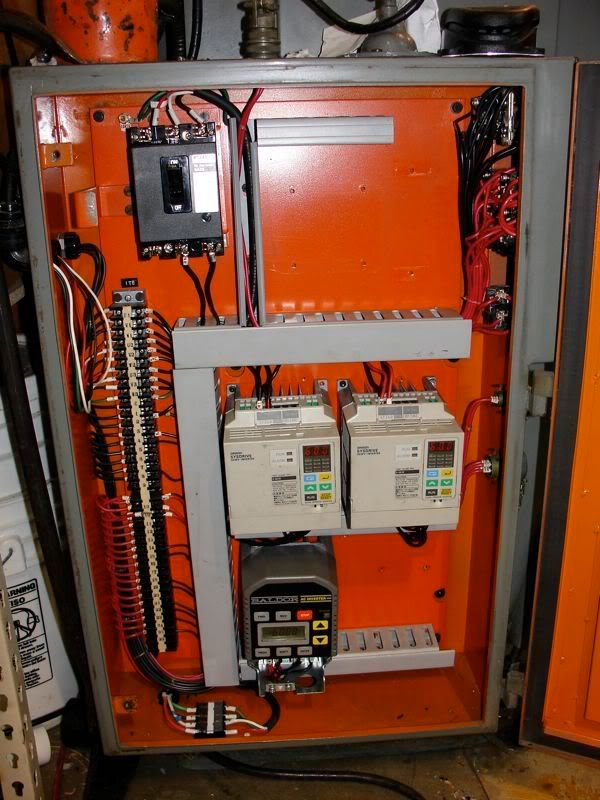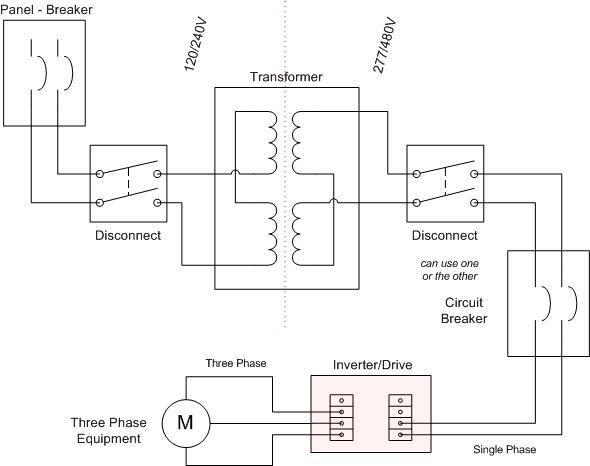There have been several discussions here and who knows how many elsewhere on how to squeeze that third phase out of a residential power system. For the purposes of this thread, I will outline what I feel are the three most practical options for converting single phase to three phase power. During the years, I have used each of these options in my shop, and will give you the results that I observed with each set up. This is meant to be a guide for someone exploring the options, and in now way will cover every situation. It is up to you to determine the best option for your needs and budget. Warning: Electricity is dangerous. Anyone looking to do any electrical project should either study the topic extensively prior to commencing any work on a given project, or better, hire the work out to a qualified electrician.
So on to the show:
So you have bought a new piece of machinery, and it has that dreaded three phase motor on it. Now what? Your options are changing the motor to a single phase motor, going to a DC motor, or converting your single phase power source to a three phase power source. We are skipping the first two as they are outside the scope of this thread.
What are the options for converting single phase to three phase?
_________________________________________________
Static Phase Converter:
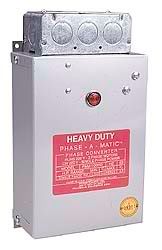
These units do exactly what they say they do, and that is they magically give you that third power leg for your motor. They are inexpensive, and are easy to install. Don't expect stellar performance from one of these units. They will merely get you by.
Pros:
Inexpensive
Small
Easy to install
Cons:
Motor only provides 2/3 of HP rating
Lacks torque
Sizing is critical
In my experience, this unit worked when the motor was warm. If the motor was cool, I had to help it start by turning the spindle by hand. The motor would easily be overwhelmed with heavier cuts, and in the end I decided this unit did not serve my needs.
In summary, a static phase converter is suitable for applications that do not require heavy starting or running torque. If one were to have a need for three phase and can sacrifice 1/3 of the HP rating of the motor, then this is an option worth considering.
_________________________________________________
Rotary Phase Converter:
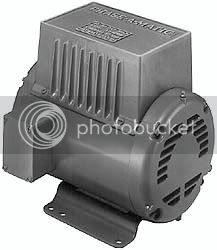
This is a unit that is designed to handle applications that require large motors (above 3HP) and heavy working torque. These units are heavy, bulky, and can be difficult to construct if you are doing it yourself. The manufactured units are easily installed.
Pros:
Can handle high starting torque requirements
Can operate multiple pieces of equipment (if sized appropriately)
Motors retain most of their rating
Cons:
Units are expensive - even if self built
Size & weight
Cost per hour can be high (a rough guess is $1.50 per hr per HP)
In my experience, I used a home built phase converter, but not for long. The electric bill broke me of that habit. With the RPC in place, my electrical cost went up over $100 in a month's time. I went back and figured for the amount of time I spent in the shop with the RPC running, that unit was costing me about $5.50 per hour to run. At that price, it doesn't take long to get SWMBO interested in the shop activities!
In summary, a rotary phase converter is the ticket when you have motor loads that require high starting or running torque. These units are expensive and usually are impractical in a home shop environment due to their initial cost, size and cost per hour to operate.
_________________________________________________
Variable Frequency Drive/Inverter:
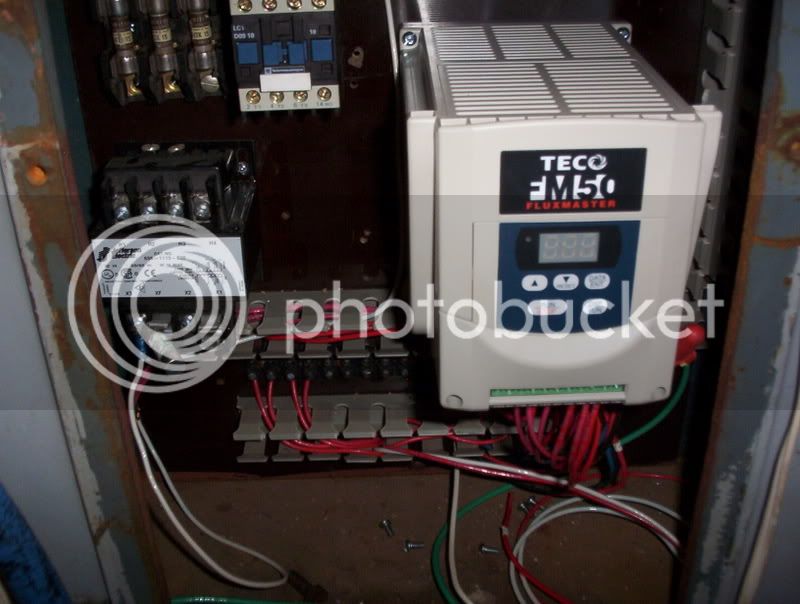
If anyone has read my previous posts on the subject, then you already know this is my favorite option for the home shop environment. Having one of these devices gives a lot of latitude over the other options for just slightly more than the equivalent static phase converter. There is good reason for my picking these units.
Pros:
Inexpensive
Infinite control of spindle speeds
Superior motor protection
Motor retains most of rating
Cons:
Difficult to install
Programming is/can be tricky
Units are slightly bulky
In my experience, this has made my milling machine a totally different piece of equipment. I get better finishes, I have much better control of spindle speeds, speed adjustment doesn't require belt changes, and the VFD/Inverter slightly reduced my electrical consumption when compared to the static converter. When the single phase motor goes south on my lathe, at three phase motor will replace it with another VFD/Inverter!
In summary, the VFD/Inverter option is likely the best bang for the buck in 90% of the home shops. These units are inexpensive, and once installed and programmed, run like a dream. These units are finicky to get set up, but a little time and patience will yield capabilities beyond imagination.
_________________________________________________
Power conversion can be a black art of sorts. Regardless of what any company claims, you will never get 100% of a motor's rating when running on single phase power. There will be efficiency loss, it is a simple matter of physics. However, don't let the issue of power conversion stop you from pursuing the purchase of that mill, shaper, lathe or other equipment. There are options, it is a matter of choice as to which is best.
As I stated above, there are options outside of this discussion as well. There isn't any one of them that is right or wrong. Each situation is different, and having the knowledge to make a decision can be worth more than the equipment itself!
Hopefully this little post will take some of the Voodoo out of the equation and will help you make an informed decision for your needs, budget, and application.
So on to the show:
So you have bought a new piece of machinery, and it has that dreaded three phase motor on it. Now what? Your options are changing the motor to a single phase motor, going to a DC motor, or converting your single phase power source to a three phase power source. We are skipping the first two as they are outside the scope of this thread.
What are the options for converting single phase to three phase?
_________________________________________________
Static Phase Converter:

These units do exactly what they say they do, and that is they magically give you that third power leg for your motor. They are inexpensive, and are easy to install. Don't expect stellar performance from one of these units. They will merely get you by.
Pros:
Inexpensive
Small
Easy to install
Cons:
Motor only provides 2/3 of HP rating
Lacks torque
Sizing is critical
In my experience, this unit worked when the motor was warm. If the motor was cool, I had to help it start by turning the spindle by hand. The motor would easily be overwhelmed with heavier cuts, and in the end I decided this unit did not serve my needs.
In summary, a static phase converter is suitable for applications that do not require heavy starting or running torque. If one were to have a need for three phase and can sacrifice 1/3 of the HP rating of the motor, then this is an option worth considering.
_________________________________________________
Rotary Phase Converter:

This is a unit that is designed to handle applications that require large motors (above 3HP) and heavy working torque. These units are heavy, bulky, and can be difficult to construct if you are doing it yourself. The manufactured units are easily installed.
Pros:
Can handle high starting torque requirements
Can operate multiple pieces of equipment (if sized appropriately)
Motors retain most of their rating
Cons:
Units are expensive - even if self built
Size & weight
Cost per hour can be high (a rough guess is $1.50 per hr per HP)
In my experience, I used a home built phase converter, but not for long. The electric bill broke me of that habit. With the RPC in place, my electrical cost went up over $100 in a month's time. I went back and figured for the amount of time I spent in the shop with the RPC running, that unit was costing me about $5.50 per hour to run. At that price, it doesn't take long to get SWMBO interested in the shop activities!
In summary, a rotary phase converter is the ticket when you have motor loads that require high starting or running torque. These units are expensive and usually are impractical in a home shop environment due to their initial cost, size and cost per hour to operate.
_________________________________________________
Variable Frequency Drive/Inverter:

If anyone has read my previous posts on the subject, then you already know this is my favorite option for the home shop environment. Having one of these devices gives a lot of latitude over the other options for just slightly more than the equivalent static phase converter. There is good reason for my picking these units.
Pros:
Inexpensive
Infinite control of spindle speeds
Superior motor protection
Motor retains most of rating
Cons:
Difficult to install
Programming is/can be tricky
Units are slightly bulky
In my experience, this has made my milling machine a totally different piece of equipment. I get better finishes, I have much better control of spindle speeds, speed adjustment doesn't require belt changes, and the VFD/Inverter slightly reduced my electrical consumption when compared to the static converter. When the single phase motor goes south on my lathe, at three phase motor will replace it with another VFD/Inverter!
In summary, the VFD/Inverter option is likely the best bang for the buck in 90% of the home shops. These units are inexpensive, and once installed and programmed, run like a dream. These units are finicky to get set up, but a little time and patience will yield capabilities beyond imagination.
_________________________________________________
Power conversion can be a black art of sorts. Regardless of what any company claims, you will never get 100% of a motor's rating when running on single phase power. There will be efficiency loss, it is a simple matter of physics. However, don't let the issue of power conversion stop you from pursuing the purchase of that mill, shaper, lathe or other equipment. There are options, it is a matter of choice as to which is best.
As I stated above, there are options outside of this discussion as well. There isn't any one of them that is right or wrong. Each situation is different, and having the knowledge to make a decision can be worth more than the equipment itself!
Hopefully this little post will take some of the Voodoo out of the equation and will help you make an informed decision for your needs, budget, and application.





